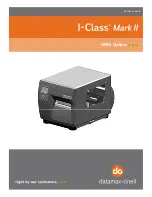
NovaJet 800 Series Training Guide
52
E. Common Mistakes
1. The printer should only be grounded to the buildings electrical receptacle/outlet using
the power cable provided and should conform to all electrical building grounding
regulations in accordance with country/regional regulations. If a printer grounding
problem is discovered only have a certified electrician ground the power source
receptacle properly.
Do not implement any of the following actions listed below or personnel
hazards and/or equipment damage may result:
a) Secondary Grounding
- If the receptacle or power strip is
grounded (or thought to be grounded)
do not attach a secondary ground to
printer under any circumstances. This
can be dangerous to the operator
and/or equipment. Introduction of a
‘ground loop’ into the equipment can
cause different problems/symptoms to
suddenly appear and can be
dangerous to the operator.
What is ground loop?
A ground loop occurs when there is
more than one ground connection path
between two pieces of equipment. The
duplicate ground paths form the equivalent of a loop antenna which very efficiently picks
up interference currents. Lead resistance transforms these currents into voltage
fluctuations. As a consequence of ground-loop induced voltages, the ground reference in
the system is no longer a stable potential, so signals ride on the noise. The noise
becomes part of the program signal.
Ground loop is a common wiring condition where a ground current may take more than
one path to return to the grounding electrode at the service panel. AC powered
computers all connected to each other through the ground wire in common building
wiring. Computers may also be connected by data communications cables. Computers
are therefore frequently connected to each other through more than one path. When a
multi-path connection between computer circuits exists, the resulting arrangement is
known as a "ground loop". Whenever a ground loop exists, there is a potential for
damage from intersystem ground noise. The ground loop theory also applies for printers
connected to these same computers, but the primary difference is computers do not pull
anywhere near the wattage demands of the printer.
While lower currents may cause a slight audible hum on signal lines (typically in
video/audio electronics), higher currents can cause more serious problems such as
sparking in connections (Ethernet port), damage to circuit assemblies signal wiring. Only


































